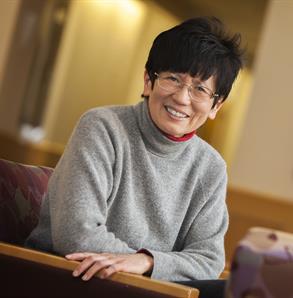
The National Institutes of Health has awarded a Washington University in St. Louis faculty member in the School of Engineering & Applied Science a total of $1.3 million to study new imaging techniques designed to better fight breast and ovarian cancers.
In her research, Quing Zhu, professor of biomedical engineering with a secondary appointment as a professor of radiology at the School of Medicine, combines ultrasound with two additional optical imaging components — diffused near infrared light and photoacoustic waves — to give doctors a more accurate understanding of a patient’s tumor and how to best treat it.

“We’re hoping down the line that we can give breast oncologists new options to predict who will respond to neoadjuvant chemotherapy and who will not. This will allow them to better determine if a different treatment regimen or earlier surgery is needed,” Zhu said.
Used on its own, ultrasound can often paint an incomplete picture of a tumor. Zhu has developed a novel approach to combine it with infrared light, which has the ability to track blood vessels and quantify blood volume typically correlated with malignant breast cancers. When used with ultrasound that guides the infrared light to target the lesions, this new technique has the potential to better determine blood volume changes, and then treatment response, on an individualized basis.
Zhu’s method is designed to be less expensive than an MRI and nuclear imaging, which are commonly used to assess a patient’s response to treatment. Early research suggests that after just a couple of weeks, the technique can show how a breast cancer patient’s tumor is responding to a particular chemotherapy regimen, based on the amount of vascular activity and changes. Zhu’s research currently involves patients with three different genetic types of breast cancer (HER2 Positive, Triple Nagative, ER Positive), each requiring its own chemotherapy regimen. She says the combined ultrasound-infrared technique shows promise that it can track a tumor’s response to chemotherapy, regardless of its genetic markers.
To better detect ovarian cancers, Zhu paired ultrasound with photoacoustic technology to better characterize the ovarian masses and distinguish benign from malignant ovarian tissue. Zhu started with a standard transvaginal ultrasound probe usually used for ovarian exams, then fitted it with a special light delivery channel. Once inserted, the light is absorbed by the suspected tumor, generating a slight temperature change which converts to sound waves. Those sound waves are then analyzed to determine a lesion’s vasculature and oxygen saturation, both markers of a cancerous tumor.
“Many patients, based on family history and other factors, opt for risk-reduction surgery,” Zhu said. “Our current screening tools aren’t as effective as we need them to be. This adds a functional extension to the typical ultrasound that can better determine if a lesion is a cancerous tumor, or a benign lesion.”
Pilot programs testing both dual-modalities are currently underway in cancer patients treated at Washington University’s School of Medicine. Zhu is working with nearly a dozen different faculty members at the medical school, including: radiologists Steven Poplack, Cary Lynn Siegel, Catherine Appleton, Catherine Young and Kathryn A. Robinson; oncologists Cynthia Ma and Foluso Ademuyiwa; surgeons David Mutch and Matthew Powell; and pathologists Ian Hagemann and Souzan Sanati. Additionally, the entire breast oncology group and OBGYN group are assisting with patient recruiting.
Zhu’s work is supported by NIH grants R01CA151570-06 and R01EB002136-12.
“These new technologies are non-invasive imaging approaches, which could allow many women to have a better quality of life if we are successful,” said Zhu.